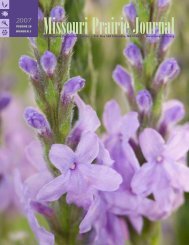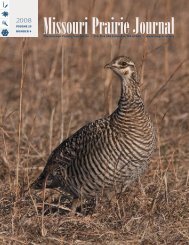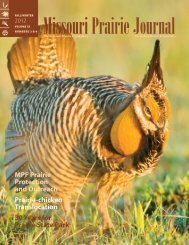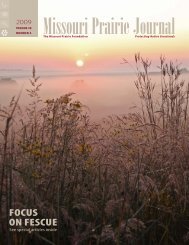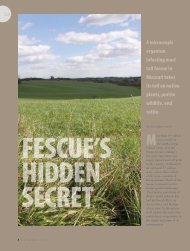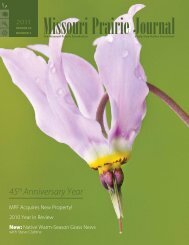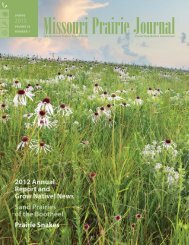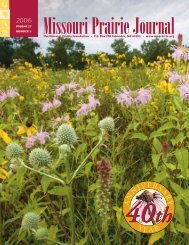Fall 2007: Volume 28, Number 4 - Missouri Prairie Foundation
Fall 2007: Volume 28, Number 4 - Missouri Prairie Foundation
Fall 2007: Volume 28, Number 4 - Missouri Prairie Foundation
Create successful ePaper yourself
Turn your PDF publications into a flip-book with our unique Google optimized e-Paper software.
Photos Justin JohnsonWhen the Show Me Energy Cooperative’s large-scale pellet mills are operational in January 2008, this huge pile ofbiomass—600 tons of residue from a seed harvest—will be processed in approximately one week. From left are JoeHorner, with the University of <strong>Missouri</strong> Commercial Agriculture Program, and at right, Ryan Milhollin, also with theUniversity of <strong>Missouri</strong>, with Steve Flick.How Biomass Energy Can BenefitGrassland Wildlife and Water QualityAccording to Flick, the best time to cut grassfor biomass energy is after the hay is past itsprime value for livestock. In fact, after the firstfrost, the grass is dry, bleached and ready to bemade into bioenergy. He says that nitrogenfixinglegumes, such as Illinois bundleflower,in combination with big bluestem and Indiangrass, produce a high BTU value. If the marketdevelops to a point where landowners canreceive a strong price per ton, fields couldbe cut well after the primary nesting season,leaving six inches above the ground to providenesting cover for the spring. While prescribedburning and patch grazing remain importanttools in prairie management, some acrescould be cut completely or burned to promotestrong regrowth and to provide bare groundfor mating and brood-rearing of groundnestingbirds. Landowners could also receivepayments for carbon credits and perhaps forassisting grassland wildlife. As research fromthe University of Minnesota has shown, a mixof 16 common prairie grasses and wildflowersproduces more biomass than a monoculture ofswitchgrass, all without irrigation or fertilizer,which improves groundwater quantity andquality, respectively.Examining the <strong>Number</strong>s• At full capacity, the Show Me Energy Co-op will process700 tons of biomass per day, which is approximately250,000 tons per year.• If seven identical facilities were built in <strong>Missouri</strong>, the totalbiomass needed would be 2 million tons annually.• A <strong>Missouri</strong> hay prairie produces between two and four tonsof biomass per acre, so up to 1 million acres of grassland couldbe needed.• There are approximately 1.5 million acres currently enrolled inthe Conservation Reserve Program in <strong>Missouri</strong>, but landownersare penalized for cutting their CRP acres for hay.• At full capacity, the Show Me Energy Co-op will produce 100,000tons of fuel pellets. That is 5 million 40-pound bags, which retailfor approximately $3 per bag, or a total of $15 million.Justin Johnson is the executive director of the<strong>Missouri</strong> <strong>Prairie</strong> <strong>Foundation</strong>. Steve Flick, boardpresident of Show Me Energy Cooperative,can be reached at 816-597-3822 orsflick@goshowmeenergy.com.Visit www.goshowmeenergy.comfor more details on the cooperative.13





